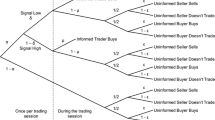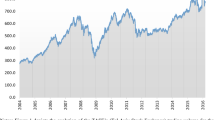Abstract
The paper develops a methodology for estimating the intra-day probability of informed trading for NYSE stocks, implied by the specialist’s quotes and depths. The time series pattern of our measure (PROBINF) in an intra-day analysis around earnings announcements is consistent with previous findings and with expectations regarding informed trading. Moreover, we find that PROBINF exhibits a strong and robust relationship with PIN, the level of insider trading and with measures of the price impact of trades. Our methodology complements the one developed in Easley et al. (J Financ 51(3):811–833, 1996a, J Financ 51(4):1405–1436, b), as it can be used to measure short term changes in informed trading and information asymmetry around events such as merger and acquisition announcements, share repurchases, stock splits, dividend announcements and index additions and deletions.

Similar content being viewed by others
Notes
Easley et al. (1996a, b) employs the sequential trade model of Easley and O’Hara (1987) to derive the probability of an information-based trade. Several subsequent papers that use the same metric for the probability of informed trading are Easley et al. (1996a, b, 1998, 2002), Easley and O’Hara (2004).
The original paper considers two scenarios regarding the trading process (the “instantaneous quote” model and the “open quote interval” model), both of them generating essentially the same set of implications. Since the focus of our paper is on the empirical implementation of the model, we restrict our analysis to the “open quote interval” scenario.
There is a possibility that the effective depth for informed traders is different from the effective depth for the liquidity traders. However, we do not attempt to model such differences.
If the dealer expects asymmetric probability of informed trading between the buy and sell side at a given level of bid and ask prices, she is likely to respond by changing the quotes. For example, if the dealer expects a higher probability of informed buying versus informed selling, she is likely to respond by increasing the bid and ask prices, thereby tending to equate the two probabilities.
Derivation of the formula is available in the “Appendix”.
We decide to use only NBBO quotes in order to address the concern of autoquotes (passive quotes posted by market dealers) raised by Chordia et al. (2001). We also perform the analysis with all NYSE quotes and the results do not change.
Specifically, we keep only the quotes that have a value of ‘N’ for the “EX” field and 1, 2, 6 or 12 for the “MODE” field.
We will retain only transactions that were reported on SEC form 4 and have a value of “P” or “S” for the “TRANCODE” field.
One concern with our methodology is that the specialist participates in a low percentage of the trades that occur on the NYSE. In fact, according to NYSEdata.com, “the specialist acted as either the buyer or the seller in 27.5 % of the share volume traded in 2000.” (The website did not provide the statistic for 2001, the year of our sample, but it is not likely to be significantly different.) Nevertheless, we argue that our methodology leads to estimates of the probability of informed trading whose cross-sectional variability is similar to the cross-sectional variability of the “true” probability of informed trading, though potentially scaled up. While a majority of the trades that take place on the NYSE do not involve the specialist, the orders that do get filled directly by the specialist or are crossed with the limit order book (which the specialist maintains) are more likely to originate from informed traders. Specifically, since informed traders are, by definition, those traders that know more than the other market participants, they are also more likely to submit orders with sizes and prices outside the inside quotes and depths. When these orders are executed, they are more likely to be executed through the specialist (from the specialist’s inventory or the limit order book maintained by the specialist), given her liquidity-providing mandate. Consequently, to the extent that a greater proportion of informed trades are executed through the specialist as compared to being matched with orders submitted by liquidity traders, then our measure of the probability of informed trading (which measures the ex-ante estimate of informed trading with the specialist) could potentially be scaled up when compared with the “true” probability of informed trading across all trades. Nevertheless, we believe that the cross-sectional variability of our measure will, with some noise or error, proxy for the cross-sectional variability of the “true” probability of informed trading, and would thus be useful in understanding the cross-sectional differences in the probability of informed trading, and relating these cross-sectional differences to firm and trading characteristics such as firm size, insider trading, and turnover.
For every trading day, we use the previous 60 daily returns in order to compute each stock’s annualized volatility. We also conducted our analysis using the annualized volatility computed from intra-day data and the results are qualitatively similar.
We are grateful to Soeren Hvidkjaer for making available the PIN measure for the probability of informed trading on his website at http://www.smith.umd.edu/faculty/hvidkjaer/.
We performed the analysis with the other two estimates of PROBINF, and the results are similar.
References
Admati AR, Pfleiderer P (1988) A theory of intraday patterns: volume and price variability. Rev Financ Stud 1(1):3–40
Bakshi G, Cao C, Chen Z (1997) Empirical performance of alternative option pricing models. J Financ 52(5):2003–2049
Brennan MJ, Subrahmanyam A (1996) Market microstructure and asset pricing: on the compensation for illiquidity in stock returns. J Financ Econ 41(3):441–464
Chordia T, Roll R, Subrahmanyam A (2001) Market liquidity and trading activity. J Financ 56(2):501–530
Copeland TE, Galai D (1983) Information effects on the bid-ask spread. J Financ 38(5):1457–1469
Duarte J, Young L (2009) Why is PIN priced? J Financ Econ 91(2):119–138
Easley D, O’Hara M (1987) Price, trade size, and information in securities markets. J Financ Econ 19(1):69–90
Easley D, O’Hara M (2004) Information and the cost of capital. J Financ 59(4):1553–1583
Easley D, Kiefer N, O’Hara M (1996a) Cream-skimming or profit-sharing? The curious role of purchased order flow. J Financ 51(3):811–833
Easley D, Kiefer N, O’Hara M, Paperman J (1996b) Liquidity, information and infrequently traded stocks. J Financ 51(4):1405–1436
Easley D, Kiefer N, O’Hara M (1997) One day in the life of a very common stock. Rev Financ Stud 10(3):805–835
Easley D, O’Hara M, Saar G (2001) How stock splits affect trading: a microstructure approach? J Financ Quant Anal 36(1):25–51
Easley D, Hvidkjaer S, O’Hara M (2002) Is information risk a determinant of asset returns? J Financ 57(5):2185–2221
Foster FD, Viswanathan S (1990) A theory of the interday variations in volume, variance, and trading costs in securities markets. Rev Financ Stud 3(4):593–624
Foster FD, Viswanathan S (1993) Variations in trading volume, return volatility, and trading costs: evidence on recent price formation models. J Financ 48(1):187–211
George TJ, Kaul G, Nimalendran M (1994) Trading volume and transaction costs in specialist markets. J Financ 49(4):1489–1505
Glosten LR, Harris LE (1988) Estimating the components of the bid/ask spread. J Financ Econ 21(1):123–142
Glosten LR, Milgrom P (1985) Bid, ask and transaction prices in a specialist market with heterogeneously informed traders. J Financ Econ 14(1):71–100
Hasbrouck J (1991) Measuring the information content of stock trades. J Financ 46(1):179–207
Hong H, Lim T, Stein J (2000) Bad news travels slowly: size, analyst coverage, and the profitability of momentum strategies. J Financ 55(1):265–295
Huang RD, Stoll HR (1997) The components of the bid-ask spread: a general approach. Rev Financ Stud 10(4):995–1034
Jeng LA, Metrick A, Zeckhauser R (2003) Estimating the returns to insider trading: a performance-evaluation perspective. Rev Econ Stat 85(2):453–471
Kyle A (1985) Continuous auctions and insider trading. Econometrica 53(6):1315–1336
Lakonishok J, Lee I (2001) Are insider trades informative? Rev Financ Stud 14(1):79–111
Lee CMC, Ready MJ (1991) Inferring trade direction from intraday data. J Financ 46(2):733–746
Lee CMC, Mucklow B, Ready MJ (1993) Spreads, depths, and the impact of earnings information: an intraday analysis. Rev Financ Stud 6(2):345–374
Lin J, Howe JS (1990) Insider trading in the OTC market. J Financ 45(4):1273–1284
Madhavan A, Smidt S (1991) A Bayesian model of intraday specialist pricing. J Financ Econ 30(1):99–134
Odders-White ER, Ready MJ (2006) Credit ratings and stock liquidity. Rev Financ Stud 19(1):119–157
Rahman S, Krishnamurti C, Lee AC (2005) The dynamics of security trades, quote revisions, and market depths for actively traded stocks. Rev Quant Financ Acc 25(2):91–124
Rozeff MS, Zaman MA (1988) Market efficiency and insider trading: new evidence. J Bus 61(1):25–44
Seyhun HN (1986) Insiders’ profits, costs of trading, and market efficiency. J Financ Econ 16(2):189–212
Seyhun HN (1988) The information content of aggregate insider trading. J Bus 61(1):1–24
Stigler GJ (1961) The economics of information. J Polit Econ 69(3):213–225
Vega C (2006) Stock price reaction to public and private information. J Financ Econ 82(1):103–133
Yohn TL (1998) Information asymmetry around earnings announcements. Rev Quant Financ Acc 11(2):165–182
Zeghal D (1984) Firm size and the informational content of financial statements. J Financ Quant Anal 19(3):299–310
Acknowledgments
We would like to thank Hank Bessembinder, Michael Cliff, John Easterwood, Huseyin Gulen, Jungshik Hur, Ozgur Ince, Gregory Kadlec, Arthur Keown, Alexei Ovtchinnikov, George Emir Morgan, Barbara Remmers, Meir Schneller, Kuldeep Shastri, Vijay Singal, Kumar Venkataraman, S. Viswanathan, Zhaojin Xu and seminar participants at the 2006 FMA Doctoral Student Consortium, Virginia Tech, University of Massachusetts Boston and Auburn University for helpful comments and suggestions. All errors and omissions are the sole responsibility of the authors.
Author information
Authors and Affiliations
Corresponding author
Appendix: Proof of Eq. (7)
Appendix: Proof of Eq. (7)
As described in the paper, the dealer’s expected revenues from liquidity traders can be expressed as follows:
At the same time, the dealer’s losses to informed traders can be expressed as follows:
Finally, the dealer’s order-processing and inventory costs can be expressed as follows:
where B is the bid price, A is the ask price, D B is the depth at the bid, D A is the depth at the ask, S 0 is the dealer’s estimate of the “true” value of the stock (B < S 0 < A), p I is the probability that the next trade originates from an informed trader (PROBINF), p BL , p SL and p NL are the conditional probabilities that the next liquidity trader will buy, sell or not trade when he faces the market maker, C(S 0 , A) is the value of an American call option on the stock with a strike price of A, P(S 0 , B) is the value of an American put option on the stock with a strike price of B, OP represents the average order processing cost per traded share, while INVsh represents the average inventory cost per traded share.
Consistent with Copeland and Galai (1983), we make the additional assumption that all liquidity traders will trade (p NL = 0), and that a liquidity trader can be a buyer or a seller with the same probability (p BL = p SL = 0.5). Moreover, setting the dealer expected losses equal to expected revenues, we obtain:
Solving for PROBINF, we obtain:
where INV represents the inventory component of the spread, and it is equal to twice the inventory component per share (INVsh).
Rights and permissions
About this article
Cite this article
Kumar, R., Popescu, M. The implied intra-day probability of informed trading. Rev Quant Finan Acc 42, 357–371 (2014). https://doi.org/10.1007/s11156-013-0345-0
Published:
Issue Date:
DOI: https://doi.org/10.1007/s11156-013-0345-0




